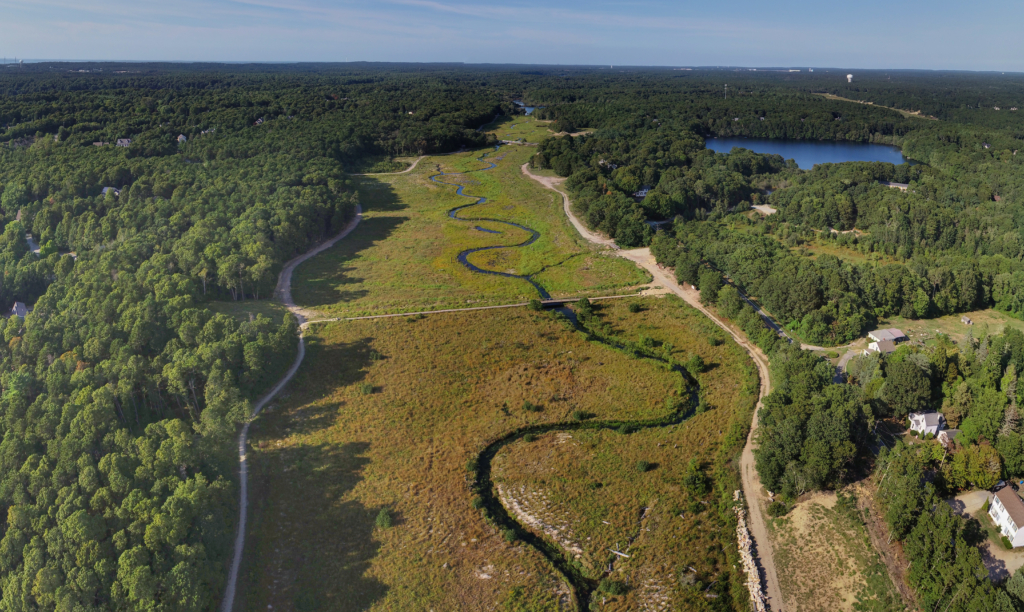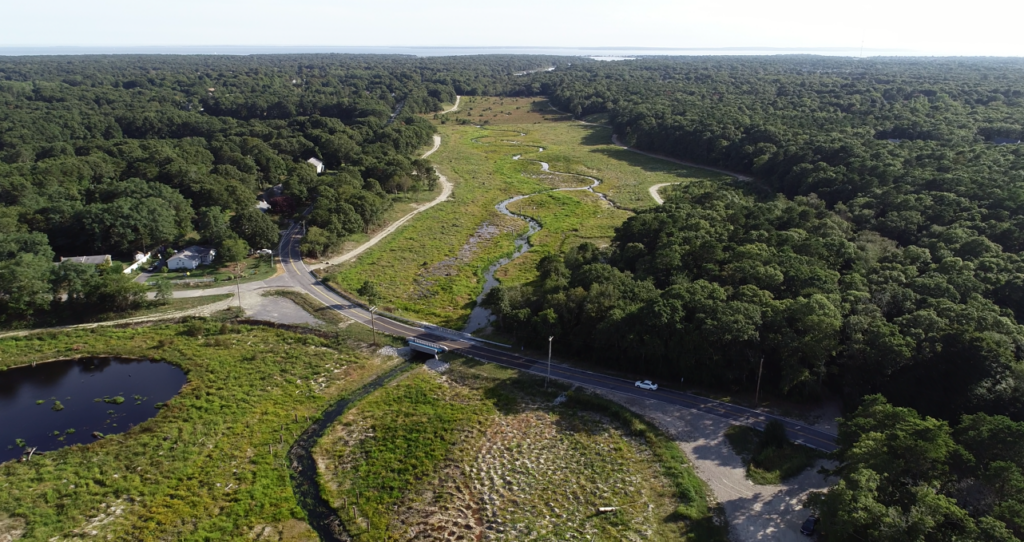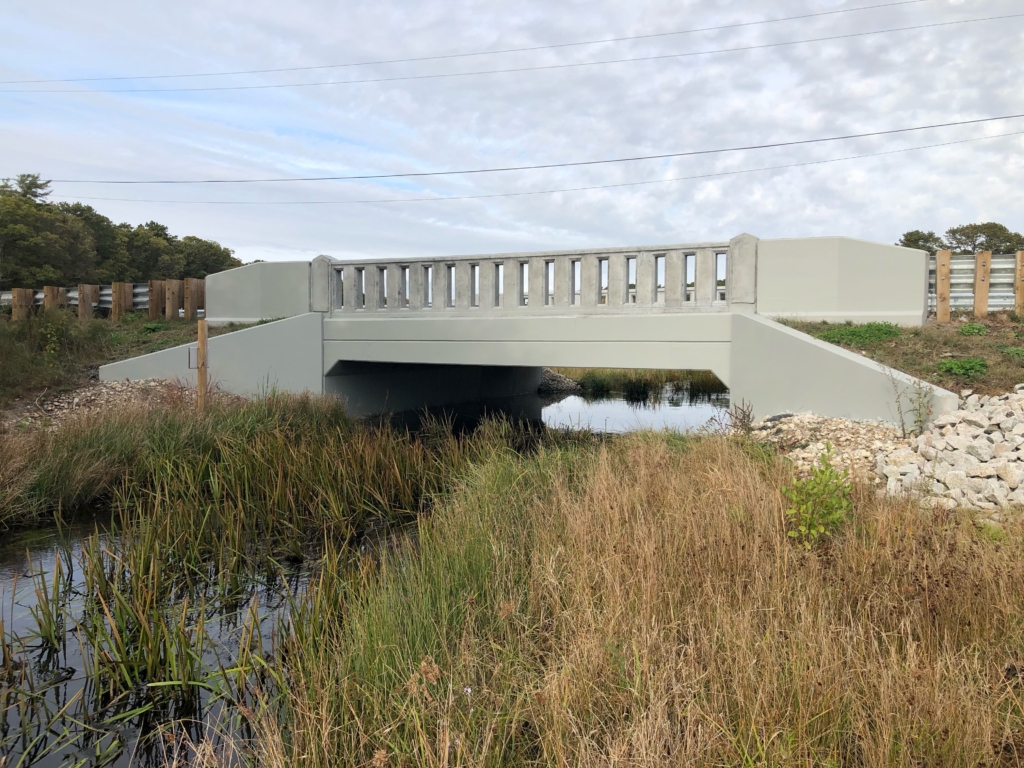Coonamessett River Restoration Project Highlighted by BSCES
Originally published by the Boston Society of Civil Engineers Section
By Eric Ohanian, PE, Project Manager, Tighe & Bond, Nicholas Nelson, CERP, Inter-Fluve, Inc., Elizabeth Gladfelter, Town of Falmouth
The decommissioning of the cranberry bogs in the 21st century presented an opportunity to restore a thriving ecosystem. The town of Falmouth had support from over 40 local, state, and federal project partners and was dedicated to the transformation of the deteriorated corridor. They had a vision to reestablish a thriving, self-sustaining river and wetland ecosystem that could support aquatic organism wildlife, and increase coastal resiliency by removing blockages and creating a connection to the floodplain. Restoration was also an opportunity to increase recreational and educational programs for people to discover the environmental and cultural history surrounding the river.
The restoration focused critical fish passage barriers along the lower mile of the river, including:
- Lower Bog Dam – This structure separated the inactive Lower Bog from the free-flowing stream and mature riparian corridor downstream. This historic stone dam constricted water flow and limited fish passage. Sand from the upstream bogs deposited in the channel in the Lower Bog resulting in aggradation, channel widening, and decreased instream habitat.
- Middle Bog Dam – This control structure was in the middle of a valley-spanning berm that separated the inactive Lower Bog with the actively cultivated Middle Bog. The flow control was set to hold water in Middle Bog at a higher elevation than that in Lower Bog. This resulted in flooding of Middle Bog during certain times of the year and a vertical drop of several feet between the two bogs that presented a barrier to fish passage. The goal at this site was to improve fish passage while maintaining water needed for the cultivation of cranberries until the upper bogs could be decommissioned.
- John Parker Road – A series of three culverts conveyed flow under the built-up roadway, separating Middle Bog and Upper Bog. The cranberry bogs on either side of John Parker Road were being actively farmed organically. The culverts under the road were undersized and in poor condition, resulting in flow restrictions and fish passage problems.
Inter-Fluve’s design began in 2013 for the fish passage and habitat improvements for the Lower Bog. While designs for the Lower Bog were underway, the Middle and Upper Bogs were taken out of production and were available for restoration. In 2016, focus shifted to the designs and permitting for these northern bogs. Designs for the lower Coonamessett River (Lower, Middle, and Upper Bogs) were approved by the Town in 2017. SumCo Eco-Contracting broke ground on the Lower Bog project in 2017, removing the Lower Bog Dam, and the river channels and wetlands were restored.
Tighe & Bond joined the project in 2016, providing expertise in bridge design, as Inter-Fluve and the Town focused on the design of the Middle and Upper Bogs. While the downstream dams and barriers could be removed, John Parker Road would remain in service, requiring a bridge to convey hydraulic flows and satisfy the environmental goals of the restoration. The bridge design required careful coordination with the river restoration design, to balance the needs of infrastructure to be cohesive and integral with the reestablished ecosystem.

Inter-Fluve’s design resulted in a channel 30% longer than the original by restoring the bends in the Coonamessett River.
Tighe & Bond worked hand-in-hand with Inter-Fluve while designing the John Parker Road Bridge, closely referencing data collections and analyses to inform their design. The team conducted their own additional studies by gathering geotechnical borings. Tighe & Bond evaluated this data to understand subsurface soil conditions for design of the bridge foundations. Armed with all this information they developed an alternatives analysis, assessing potential configurations to replace the failing culverts, and meet the hydraulic and ecological needs of the river. Bridge design consisted of a 24-foot precast concrete frame on pedestal spread footings, which was reviewed by MassDOT and completed in 2019. Tighe & Bond provided construction administration and observation until the bridge and the broader restoration project for Middle and Upper Bogs was complete in June 2020.

An aerial view of the finished John Parker Road bridge and the Coonamessett River.
The restoration project included design for upgrading infrastructure and land use in ways that looked to address past problems and meet current standards, while simultaneously looking towards challenges of the future. The fully restored Coonamessett River and the addition of the John Parker Road Bridge ensure that the Town of Falmouth has increased its conservation area’s resiliency to climate change. The Lower Bog in particular will see the most coastal impact from storm surges that cause coastal flooding, creating a floodplain with storage capacity. Inter-Fluve’s experts recognized that the continuing rise in sea-level will flow into river valleys, so their design needed to be able to adjust over time. This also allows for salt marsh migration upstream and channels to change size as sea level rises. The removal of barriers and integrated bridge allows water to move upstream with the tides and flood water to freely spread out onto the upper floodplains.
The Town of Falmouth has noted that since the restoration, seeds from wetland plants that had been buried for 300 years under mill ponds and cranberry bogs sprung to life once original wetland soils were uncovered. Insects (butterflies, dragonflies, and pollinators), fish and other wetland animal species populations have shown dramatic increases. The John Parker Road Bridge was specifically designed to be tall and wide enough to handle fish passage, flooding, and allow storm debris to continue flowing down the river. The bridge design also addressed social, sustainable, and economic needs for the Town of Falmouth. As the town implements walking paths throughout the restoration area, the design team made sure that the bridge would become part of that experience. With an aesthetically pleasing design, a wider bridge structure, and sidewalks with guard rails, the public can now walk safely along the road and enjoy the expansive view of the bogs. The materials for this precast concrete bridge were chosen to provide a low cost and durable solution and one that would hold up to the exposure to salt water. The engineers limited the amount of exposed steel and avoided any corrugated metal pipe or steel beams in the design. Tighe & Bond’s bridge details implemented Accelerated Bridge Construction methods which also cut down on project costs and travel disruption, and enabled flows though the bridge sooner than conventional construction. John Parker Road Bridge is now in compliance with modern MassDOT requirements and Massachusetts River and Stream Crossing Standards. The ecosystem and modern infrastructure needs were carefully designed to work together in tandem. Fish now pass along the restored river today, and for decades to come.
Says Elizabeth Gladfelter, Falmouth Conservation Commission Member: “The Coonamessett River restoration achieved its goals to be a nature-based solution to increase resiliency to climate change and community resiliency. This project has increased awareness and stewardship of natural resources in Falmouth and both formal and informal educational programs.”

The finished John Parker Road bridge allows for free-flowing water and unobstructed fish passage.
To achieve the main goals of this project, the town of Falmouth established a partnership with many organizations that supported the journey of this restoration. Over the course of the project stages there were 17 grants and private donations, totaling approximately $5 million. The town’s work to navigate this complex array of funding allowed Inter-Fluve and Tighe & Bond to work alongside the project partners, Coonamessett River Trust, and the 300 Committee Land Trust to take their design requirements and needs into account. The design teams took on the challenge of high-level expectations and complex requests to make sure the designs met the grant requirements while also effectively restoring the ecosystem.
To celebrate the success of the collaborative effort, the town hosted a ribbon cutting in 2021 where all project partners, local educators, and members of the native Wampanoag joined to celebrate a true ecological marvel. The project contributes to both the engineering and environmental industries by addressing past environmental issues, upgrading to modern design standards, and providing a resilient restored environment to help address needs of the future.
The American Council of Engineering Companies of Massachusetts (ACEC/MA) awarded Tighe & Bond, Inter-Fluve, the town of Falmouth, and project partners with a 2022 Bronze Engineering Excellence Award. The project team was also awarded the 2022 Environmental Business Council of New England (EBC) Nicholas Humber Award for Outstanding Collaboration.
The hard work and careful considerations from the project team serve as a model for future projects, and the successes are a catalyst for other communities inspiring to restore the ecological health of their rivers.


